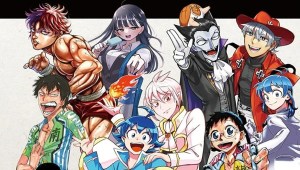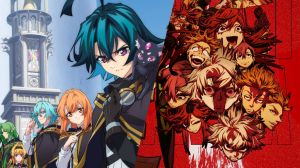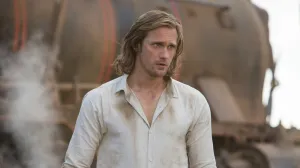Costume designer Ellen Mirojnik is no stranger to conjuring all sorts of big-screen wardrobes for a wide swath of projects – from the flashy like The Greatest Showman to the decidedly down-to-earth like Logan Lucky. But she was recently tasked with crafting a most challenging series of enchantments: the costumes for Angelina Jolie, Elle Fanning, and Michelle Pfeiffer for Maleficent: Mistress of Evil.
Videos by ComicBook.com
With the film bowing on home video this week, Mirojnik joined ComicBook.com to open her stylistic spellbook and reveal the ingredients that made her magical contributions come together.
ComicBook.com: I’m sure that this was a really fun project given the amount of imagination you were allowed to invest in it, and I know you have a previous working relationship with Angelina Jolie, so tell me about that collaboration to start. There was already an established look for Maleficent, but what was fun about working with Angelina to bring it forward in this movie?
Ellen Mirojnick: What was great fun about it was that this was a task, because there were giant wings. So how does Maleficent then become this creature that flies? Not only does she fly, she gets introduced to her origin. So the combination of those elements, these are two new elements that we have seen in quick preview in the previous Maleficent. It was really an enticement to become involved with this film: how do you make the glorious character look enticing with her wings and then, how to take a costume and have it work in a way that it evolved in the land that she learns is the place of her birth, of her origin.
They are abstract notions, but as a result, working with Angie and trying to figure this out was a great, great exercise, because you’d go from one thing that was possibly too costume-y to then the simple-ness of the flutter of the dress, the simple-ness of thinking about like a ballet dancer as what they have to work with. Having the extension of the body, to thinking about where is this tribe? Who is this tribe? What is the biome that she comes from? How do we relate this to then?
It was a really tough exercise but then, it was a lot of experimentation. That was really, really great, designing Maleficent, in that basically you’re designing a character that you don’t really have a full grasp in real life to the dimension and the size of the wings. That is another element that’s added afterwards. You’re somewhat dealing with a two-dimensional character as opposed to what we normally design.
You sketch it, try to figure it out. And we always had a model of the size of the wings so they could be figured out, but the reality of it is really questionable. But what Angie always wanted was the graphicness of black and white. That was our point that we began with, and I think that’s what we ended with as well. Is that there is a beauty in that simplicity and that graphicness. That’s what we did there.
Tell me what impresses you about how Angelina recognizes what’s going to work both for her as an actress and for the character in terms of her wardrobe.
She has a great natural instinct and also she has a really perfect overview of the film and the story and who the character is. There’s two different elements working at the same time. She will always hold the view of the entirety of the film. Not many people actually really could do that successfully. She was the producer as well as the actor, the star and an actress, but she held the overview of what the whole film is, aside from who the Maleficent character is in the present, and where she goes and how she evolved. I think that genius and that instinct is rare but she has it in a way that just instinctually is fine-tuned.
And you also got to evolve the look that Elle Fanning’s Aurora has. Tell me what was fun about sort of pushing that a little forward for the second film.
It was great fun actually because Elle really wanted to be Sleeping Beauty, the [traditional] animated Sleeping Beauty, and so how do you get all the elements of what the story tells about evolving her to the essence of the real princess who is Sleeping Beauty, especially in our Disney environment?
What was wonderful about it was the beginning when we first meet her when she is Queen of the Moors, the gown that we meet her in is quite fantastical and it looks as if it was woven by the little hands of the fairies. It’s made of leaves in the most perfect arrangement, if you will. But that’s simplicity: that natural element and that of nature evolved into the Queen’s ideal of who this girl will be.
You contrast that nice and natural simplicity with the very, very structured clothes, gowns of the court and it shows two different sides immediately. You see her discomfort in that tightness, that structure – and that is beautiful, but it is very, very, very structured and she’d learned that she is not that woman.
Her ease in evolving from the Queen of the Moors into who she winds up as being in the Queen of Ulstead, and marrying the Prince is a beautiful evolution of a natural myth into a rejection of structure, into our understanding of the worlds coming together and not having any separation. Whereby the structure of what Queen Ingrith tried to impose that made her so uncomfortable. She learns immediately that, that’s not her and she rails against it. She cannot become that. But what she understands in the end is that Sleeping Beauty is the one that can bring all of the kingdoms together as well as a love with her prince.
It was great. Elle was wonderful and wanting to explore each moment. And she was wonderful in becoming the 21st-century Queen of Ulstead, a 21st-century Sleeping Beauty.
And then the trifecta here is getting to work with Michelle Pfeiffer to create a new look with Queen Ingrith. And Michelle has also worn some of film’s great costumes – Catwoman’s stitched leather, Suzie’s red dress in The Fabulous Baker Boys, and on and on – so tell me what was unique and special about working with her?
Michelle is a great, great woman to work with. She’s like a queen goddess, she has worn some magnificent costumes over the course of her career. When meeting her, we always felt that Queen Ingrith was an icy queen. She was one of greed, purpose, motive, and whatever she wants, she takes. But this was before Michelle came into our picture. We just understood that as the character in which we had to portray Queen Ingrith that was out in terms of design, giving it away immediately that she was the evil queen.
It was great to design a queen that was very non-stereotypical, non-evil … to design a queen of a kingdom that had the riches and the potential to have even more riches and be able to become the largest kingdom of that land was very, very exciting.
When Michelle came into our story and as the designs were perfected for her, it was great to see them come to life because she just … I can’t explain it. She walked into a dress, into the fitting room as Michelle Pfeiffer and walked out from behind the curtain as Queen Ingrith – each and every costume, she brought such royalty and poise to each costume that it was thrilling to just work with her. And when things didn’t work, if the neckline needs to be changed, if a color needed to be changed, if the position of her armor needed to change it, it was so clear on how to make that happen. I was just insane how clear it was.
As you figured out your vision for the entire film, you have the animated film to inspire and you had the foundation laid down from the first film. When your imagination can run wild in a place like this, what kind of rules did you give yourself as you figured out the vision for the looks that appear throughout the film?
That’s a great question. I would say that this feels real: does it feel not like a costume? And what I mean by that is even if it’s elaborate, does it not [feel like a costume]? I did not want it to feel theatrical. A theatrical costume is something that, in my mind, would be something that you would see live on a stage. This you had to feel as if they were really part of the world, part of the essence of what they had, what their performance needed to be.
The rule was, as fantastical as they can be, is it real? And I would say that was the only rule, that was the set of rules for each character, for each environment, for every part of the film. Was it real? Could it be more real? Could it be less real? It was a striking a balance, but it had what to do with the reality of what the audience would see.
You’re going back into fairy tale territory with Cinderella. Tease me a little bit about what your approach taking on an entirely different fairy tale is going to be.
Well, let’s say that this fairy tale is going to be very, very different because it is a fairy tale. It has a large mix of different periods to create our own period of time. But most importantly it’s a musical, so it does lend itself in risking breaking my rule to a bit of the applicability and as fun. Cinderella‘s been told many different times and in fact, I told one Cinderella many, many years ago. But this Cinderella is very different because it is a retelling of the story and it actually is a revision of Cinderella for the 21st century and, without giving too much away, she becomes a very, very strong independent woman.
That in itself is fun. And the periods of time that it takes place in is a very magical time without it being specific to any one period. I’m at the very beginning. Let’s have this conversation like two months now!
*****
Maleficent: Mistress of Evil is available now on Blu-ray, DVD, and Digital HD.








